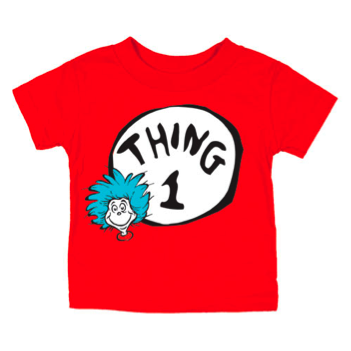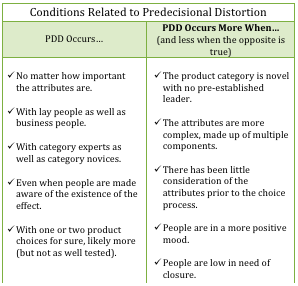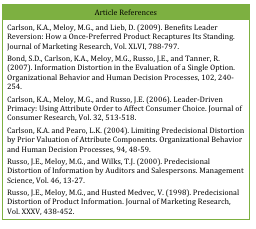FIRST THINGS FIRST! USING PREDECISIONAL DISTORTION TO ESTABLISH AND MAINTAIN BRAND PREFERENCE
 If you’re interested in establishing and maintaining your brand as your targeted customers’ preferred choice (and why wouldn’t you be?), understanding and applying Predecisional Distortion – a behavioral economics irrationality – could be your answer. In this article, we define Predecisional Distortion and describe how you can apply it to establish and maintain your brand’s preference and choice.
If you’re interested in establishing and maintaining your brand as your targeted customers’ preferred choice (and why wouldn’t you be?), understanding and applying Predecisional Distortion – a behavioral economics irrationality – could be your answer. In this article, we define Predecisional Distortion and describe how you can apply it to establish and maintain your brand’s preference and choice.What is Predecisional Distortion (PDD)? It’s the phenomenon by which the value of attributes being considered later in a sequential attribute consideration process are distorted (a.k.a. biased) in favor of the brand that was initially established as the preferred leader (in the same process).
Key to PDD is initial establishment of the preferred (i.e., leading) brand. How is that done? Consider the partial title of our article – FIRST THINGS FIRST! In PDD, a brand is established as the leader by presenting an attribute that favors that brand first in the sequential attribute consideration process.
For example, imagine that you’re beginning a search for a home security system. You’ve never had one before, so your knowledge about them is limited and your preference for a particular brand has not been established. As you begin your search, you see that two brands are compared for whether or not they have wireless connectivity to a central monitoring facility, the benefit being that wireless connectivity prevents thieves from cutting phone lines to de-activate the system. Brand A has wireless connectivity, Brand B does not. Therefore, you prefer Brand A at this initial point in your consideration process; that is, Brand A has been established as your leading brand. PDD occurs as you consider more attributes and evaluate each brand’s performance on those attributes. PDD states that your evaluation of the brands for subsequent attributes will be biased in favor of Brand A.
Although not commonly recognized as such, PDD can be considered a behavioral economics irrationality that lends to “choice architecture” because it demonstrates decision processing that runs counter to what would be predicted by rational economic theory. Rationally, the net value of all attributes considered independently would identify the preferred brand. However, that’s not what typically happens. Research shows that attributes’ values change depending on where they fall in the sequential consideration process.
*For more examples of choice architecture phenomena, see our articles on Anchoring and Adjustment, Temporal Discounting, and Hot-State Decision Making.
Powerfully, this distortion is not limited to neutral attributes (i.e., attributes favoring no one brand). Some studies have even shown that attributes clearly favoring one brand independently, or when brand preference has not already been established, are evaluated in favor of an inferior brand on that attribute, if that inferior brand had been initially established as the preferred leader.
Two examples are in order:
- In studying two-brand backpack and restaurant choices, Carlson et al. (2006) found that 94% of their respondents identified a brand as preferred after seeing attribute information that favored that brand first. Once this brand had been established as the leader, 70% of these respondents ultimately chose the leading brand after five more attribute comparisons, one of which was pre-tested to favor the non-leading brand and four of which were pre-tested to favor neither brand. Furthermore, among the 94% for whom a first-attribute preference had been established, all four neutral attributes and the competitively-favored attribute were evaluated to favor the leading brand.
- Generalizing PDD to single-brand choices (i.e., when one is considering purchasing a brand or not), Bond et al. (2007) found that significantly more respondents considering purchasing a PDA (personal digital assistant) claimed that they would purchase the PDA if the first of six attributes evaluated was favorable (48% would purchase it) than if it was not (22% would purchase it). Furthermore, like the results above, the average evaluations of the non-favorable PDA attributes (four neutral and one unfavorable) were all significantly higher when the first attribute evaluated was favorable toward the PDA than when it was not.
 Although PDD is robust, there are certain conditions for its manifestation. The table at left lists the most predominant. Although the exact dynamic behind PDD is not clear, researchers (particularly Bond et al., 2007) have identified coherence-directed processing to explain the bias. Simply stated, coherence-directed processing means that we naturally seek a state of equilibrium, avoiding instability. Distorting attributes to preserve the leading brand results in this desired equilibrium. Regarding PDD conditions, an interesting and important dynamic appears when product cost is one of the attributes being considered. Research has shown that favorable product costs for a competitive brand (e.g., a substantial lower standard cost or deep discounts) can usurp an initially established leader (Carlson et al., 2009). In this case, product cost is less distorted and has the ability to change the preferred leader in the consideration process. However, this same research shows that the initial non-cost leader, called “the benefits leader,” can be re-established if subsequent non-cost attributes are presented, even if they are neutral or don’t favor the targeted brand. This phenomenon is called Benefits Leader Reversion. So what are the implications of PDD for successful marketing and promotions? First, for all applications, target PDD tactics for novice vs. expert consumers. Then, follow the rule of FIRST THINGS FIRST! Where your brand has a clear advantage for a particular attribute (preferably other than cost), position consideration of that attribute first. And if a competitor later trumps you with a better price, have no fear. Work to follow up consideration with a non-cost attribute. More specifically, here are five ways to apply PDD:
Although PDD is robust, there are certain conditions for its manifestation. The table at left lists the most predominant. Although the exact dynamic behind PDD is not clear, researchers (particularly Bond et al., 2007) have identified coherence-directed processing to explain the bias. Simply stated, coherence-directed processing means that we naturally seek a state of equilibrium, avoiding instability. Distorting attributes to preserve the leading brand results in this desired equilibrium. Regarding PDD conditions, an interesting and important dynamic appears when product cost is one of the attributes being considered. Research has shown that favorable product costs for a competitive brand (e.g., a substantial lower standard cost or deep discounts) can usurp an initially established leader (Carlson et al., 2009). In this case, product cost is less distorted and has the ability to change the preferred leader in the consideration process. However, this same research shows that the initial non-cost leader, called “the benefits leader,” can be re-established if subsequent non-cost attributes are presented, even if they are neutral or don’t favor the targeted brand. This phenomenon is called Benefits Leader Reversion. So what are the implications of PDD for successful marketing and promotions? First, for all applications, target PDD tactics for novice vs. expert consumers. Then, follow the rule of FIRST THINGS FIRST! Where your brand has a clear advantage for a particular attribute (preferably other than cost), position consideration of that attribute first. And if a competitor later trumps you with a better price, have no fear. Work to follow up consideration with a non-cost attribute. More specifically, here are five ways to apply PDD:
- In face-to-face sales situations, have your salespeople tell customers about an attribute that favors your brand first. Don’t wait till later with the thought of saving the best for last.
- When you have control of brand or product comparisons (e.g., in online presentations, retail sales situations, or restaurant menus) and want to sell a higher margin brand or product, make sure attributes that favor that brand are presented first, hopefully as sequentially as possible.
- In shopping situations, look for opportunities to present attributes favorable to your brand before they get to the specific shelf space where they can see attributes that may favor other brands. For example, position favorable attribute information within an aisle or on an end-cap an aisle or two before your brand’s aisle.
- On outdoor advertising that allows you to sequentially promote your brand across several billboards, make sure the first billboard in the sequence presents your most favorable attribute.
- Consider leading with strong image-oriented campaigns before moving to attribute-oriented campaigns. As long as the image favors your brand and establishes a positive preference, attributes that follow have a good chance of being distorted in your favor.
Thanks for your time and remember – FIRST THINGS FIRST! We hope this helps and we welcome other ideas you may have for applying Predecisional Distortion. Send us your comments!


Wonderful introduction to PDD, would love to learn more by reading the actual research articles! This summary has excellent real world application for a non-academic audience.